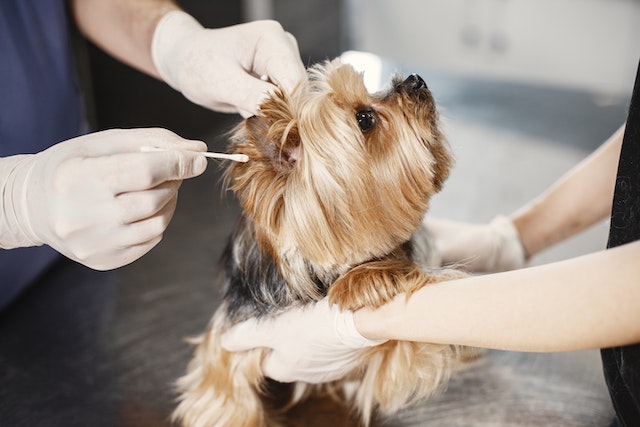Dog anal glands, also known as anal sacs, play a small but significant role in a canine’s overall health and well-being. These small sacs are located on either side of a dog’s anus and are responsible for secreting a pungent substance that aids in marking territory and communication with other dogs. While many dogs naturally express their anal glands during bowel movements, some may experience issues such as impaction (when the glands become blocked) which can be very uncomfortable to downright painful. Understanding the function and potential problems associated with dog anal glands is essential for pet parents to ensure the health and comfort of their pets.
What are Symptoms of Impacted Anal Glands in Dogs?
Here are some common signs that a dog’s anal glands may be impacted or infected:
Scooting:
One of the most common signs is scooting or dragging the hindquarters along the ground. This behavior is an attempt to relieve the discomfort associated with the anal glands.
Excessive Licking or Biting:
Dogs with anal gland issues may excessively lick or bite at the base of their tail or around the anus.

Foul Odor:
Impacted anal glands can produce a strong, unpleasant odor. If you notice a foul smell around your dog’s rear end, it may be a sign of anal gland problems.
Discomfort or Pain:
Dogs may show signs of discomfort or pain, especially when sitting down or defecating.
Swelling or Redness:
Swelling, redness, or irritation around the anus may be indicative of anal gland issues.
Changes in Behavior:
Dogs with anal gland problems may exhibit changes in behavior, such as restlessness, increased agitation, or signs of anxiety.
Abscess Formation As a Result of Impacted Glands
Impacted anal glands in dogs can potentially lead to the formation of an abscess (a pocket of pus) when the glands become infected. This can occur when the fluid within the anal glands becomes thickened or blocked, creating an environment where bacteria can proliferate. If the condition is not addressed, the infection may progress, causing the glands to swell and form an abscess which appears as a swollen, painful lump.
If you notice any of the above symptoms in your dog, it’s crucial to consult with a veterinarian. The vet will examine your dog and, if necessary, manually express the anal glands to relieve the impaction or lance the abscess if there is one. In some cases, antibiotics or other treatments may be prescribed if there is an infection.
Wait…Does My Cat Also Need His or Her Anal Glands Expressed?
Cats typically do not require routine anal gland expression in the same way that some dogs might. Unlike dogs, cats have smaller anal glands, and these glands usually express themselves naturally during bowel movements.
However, there are situations where a cat’s anal glands may become impacted or infected, leading to discomfort or other issues. If you notice your cat displaying signs of anal gland problems, such as scooting their hindquarters along the floor, excessive licking or biting at the base of the tail, or signs of discomfort during defecation, it’s important to consult with a veterinarian.
How to Prevent Anal Sac Impaction in Your Dog:
Preventing dog anal sac impaction involves a combination of proper care and monitoring. Here are some preventive measures below.
High-Fiber Diet:
Feed your dog a high-fiber diet to promote regular bowel movements, which can help naturally express the anal glands. This could include things like pumpkin, sweet potatoes or green beans. As always, consult with your vet.
Regular Exercise:
Ensure your dog gets regular exercise, as physical activity can contribute to healthy bowel function.
Maintain a Healthy Weight:
It is found that overweight dogs tend to have chronic anal sac problems. Be sure to maintain your dog’s weight through a balanced diet and regular exercise.
Anal Gland Expression:
If your dog is prone to anal gland issues, ask your veterinarian to show you how to properly express the glands or have a professional groomer do it regularly. We at Collar Cuts include anal gland expression in both the brush & bath and full-service grooms for dogs.
Regular Vet Check-ups:
Include anal gland checks as part of your dog’s routine veterinary examinations to catch any potential issues early.
Hygiene:
Keep the area around the anus clean and dry, as poor hygiene can contribute to anal gland problems.
Conclusion
Certain dog breeds are more susceptible to anal gland impaction due to factors such as smaller body size, specific gland anatomy, soft stools, or gastrointestinal issues. Breeds like Chihuahuas, Dachshunds, Toy Poodles, Bulldogs, French Bulldogs, Cocker Spaniels, Basset Hounds, overweight dogs, and certain terrier breeds, including Jack Russell Terriers, are commonly associated with anal gland problems. Despite breed predispositions, any dog can experience anal gland issues. Recognizing signs and implementing preventive measures, such as regular veterinary check-ups and proper care, is crucial for mitigating the risk of anal gland impaction in dogs.
Sources:
Petmd.com
thedodo.com
thesprucepets.com
Vcahospitals.com
openai.com




